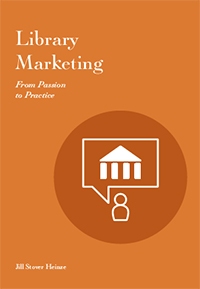
Library Marketing: From Passion to Practice
Skip other details (including permanent urls, DOI, citation information): This work is licensed under a Creative Commons Attribution-NonCommercial-NoDerivatives 4.0 International License. Please contact [email protected] to use this work in a way not covered by the license.
For more information, read Michigan Publishing's access and usage policy.
Gaining an Edge
Competing for Customers Is Living Your Mission
Entering a competitive state of mind can be a stretch for librarians, but like other marketing-related concepts, the notion of competition carries with it some inaccurate associations. For one, competing does not mean succeeding at the expense of someone else. Organizations can win simultaneously by succeeding in their areas of strength and by cooperating. One only needs to look to the incredible variety of organizations within sectors like retail, higher education, nonprofit, and entertainment to see that many entities can coexist in the same sphere. Think too about library consortia in which librarians build cooperative collections and participate in joint initiatives that would be impossible to take on alone. Moreover, competition affects every organization, no matter how far removed from “business.” Librarians face external competition from search engines, bookstores, coffee houses, and entertainment venues, as well as from internal threats such as other units on campus demanding a larger share of the budget. While some of these competitors are very distinct from libraries, our users’ experiences with competing organizations influence what they expect we should be able to do for them. (How many times have users said that they expect library catalogs to work like Google or Amazon?) Ignoring competitors is, in effect, ignoring our users’ point of view, which is antithetical to both marketing and librarianship.
Peter C. Brinckerhoff (2010), author and marketing consultant for nonprofit organizations, expressed the value of competition in his book Mission-Based Marketing. In it, he draws from his extensive nonprofit marketing experience to offer readers the following mantra: “Repeat after me: Competing is not bad. Competing is not immoral. Competing means continuing to be there to do good works. Competing makes us better. Competing means doing more mission” (p. 25). When we compete, we effectively tell our users that we value their viewpoints and that we have confidence that what we offer is worth their time relative to anything else they could be doing.
You have surely heard the phrase “healthy competition” at some time or another. There is a reason those words are frequently paired—recognizing the strengths of competitors prompts one to stay sharp and current with what is happening in the marketplace. More importantly, competitive pressures nudge organizations to think carefully about the unique value they can deliver to their users. Putting competitive thinking into practice will force you to examine your work in its proper real-world context.


